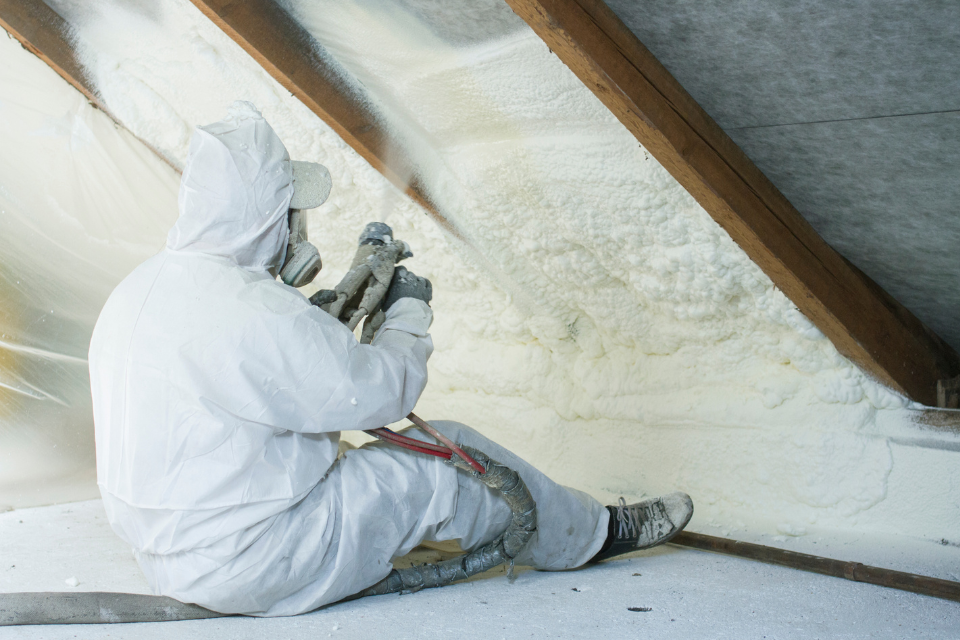
Some of us may be wondering if an improvement in our home’s energy efficiency could reduce our bills and so be looking to replace windows, doors or wall insulation, or investigating alternative forms of heating such as heat pumps, infrared or solar panels. Many will look to the roof and how to improve the insulation.
If you own a buy to let property, your EPC rating could affect your borrowing potential, how much rent you could charge your tenants, and even make your property more attractive to prospective tenants. Currently buy to let properties must meet EPC level E in order to rent them out, but by 2025 any new contract will need a C rating and by 2028 all properties will need that C.
MK Mortgages founder, Marc spoke to Royal Institution of Chartered Surveyors (RICS) regulated building surveyor Reuben Diffey on the topic of spray foam insulation as a way to reduce the heat lost from your property’s roof. Whilst on the surface it might seem like a sensible thing to do and could save you money in the long-term through reduction of your heating bills, it could in fact be doing more damage to your home than you realise. Reuben gave us a stark warning in the form of a case he came across in his surveying work.
“To cut a long story short the owners were both in their eighties and were contacted by a spray foam company offering to undertake a free survey. The couple were keen to improve the thermal insulation of their house and thought this would be a good idea. There appears to have been a bit of pressure selling and the client agreed to the works having been quoted £13,000. However, when the client changed their minds and rang back to advise the company who said they will be happy to cancel it if that’s what was wanted, they offered to send a more experienced technician to explain the benefits to them. During the 2nd visit a few days later, the ‘more experience’ technician advised additional works were required and the quote then jumped up to £25,000.
Using BuildDesk software I undertook my own U-value calculation/CRA with frightening results.
The level of insulation provided only provides a U-value of 0.46 W/m2K which falls very far short of the building regulation standards of 0.18 W/m2K as required.
This situation is potentially worse given that the exposed area of the thermal element (i.e., the sloping elevations to the roof) will have a larger surface area than the original thermal element (ceilings) therefore the heat loss is over a wider area.
In addition to this, the U-value that has been achieved is only marginally better than the U-value of the original construction with the insulation between the ceiling joists with mineral wool insulation.
The CRA that I undertook also showed a significant risk of condensation on a month-by-month basis throughout the year. The minimum condensation being 222g/m2 in July with a maximum of 1202g/m2 in December which equates to 1.2litres per square meter of roof!” Reuben Diffey, Chartered Surveyor, Property Formula
Although mortgage lenders are looking to support your energy performance improvements you do need to be careful as you may end up opting for something that isn’t acceptable by your lender or other lenders (when remortgaging or selling your property).
There are many stories of homeowners taking on spray foam loft insulation only to find that when they go to sell it’s a struggle because the spray foam doesn’t meet the purchasers lenders criteria.
Removal of spray foam insulation is particularly challenging and in many cases can only be achieved by removing roof tiles and re-tiling.
Having completed research there are many lenders that do not offer mortgages on properties that have spray foam insulation which can be a major headache when you decide to sell. You can have similar issues with properties that have solar panels, although many lenders are now happy with this, but it can depend on the style and contract that are in place.
There’s a phrase in the mortgage industry that lenders rely upon when it comes to the valuation of a property – ‘subject to the valuers comments’ which means that the opinion of the qualified valuer will dictate whether the property is worth what you are paying or remortgaging for, or that the property is suitable for securing the lenders loan against.
Think carefully before opting for spray foam insulation
The Royal Institution of Chartered Surveyors (RICS) has launched an impartial and comprehensive guide written by subject matter experts to update consumers on the latest guidance about the use of spray foam as a method of insulating residential properties.
If you want to contact a professional with experience of spray foam insulation, please contact Reuben Diffey, MRICS to discuss.
More stories on the risks of spray foam insulation:
HomeOwners Alliance: Spray foam roof insulation warning to homeowners
Financial Times: Advisers issue mortgage warning against use of spray foam insulation
iNews: Foam insulation approved under government green homes scheme renders 250,000 homes worthless






